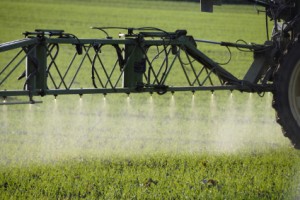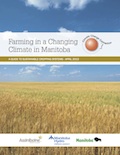
On this page, we deal with the following subjects. These good management practices for both manure and synthetic fertilizers can help lower greenhouse gas emissions and represent economic savings for the farmer.:
- Soil testing
- Fertilizer application
- Fertilizer incorporation
- Fertilizer application timing
- Precision Farming
Click a link in the list above to jump to that topic on this page.
Sustainable nutrient management revolves around the non-excessive use of synthetic or natural fertilizers.
This practice benefits both the farmer and the environment when proper techniques are used. Improving the efficiency of fertilizers should lower application rates and costs, while reducing the amount of nutrients that can be lost to the environment through leaching, denitrification, or volatilization.
Of the four major nutrients (nitrogen-N, phosphorous-P, potassium-K, and sulfur-S) applied as synthetic fertilizer, N is the nutrient most easily lost. Nitrogen causes the most environmental damage and economic loss to the farmer.
Nitrous oxide (N2O) is the most potent agricultural greenhouse gas (GHG), having 298 times more environmental impact per one molecule of gas than carbon dioxide (CO2). In Manitoba, N2O accounts for 66 percent of all agricultural GHG emissions.(1) Nitrogen is lost through many pathways, increasing the chance of loss to the environment.(2) Most losses happen when too much N fertilizer is applied and denitrification occurs. This nutrient can also be lost to groundwater or volatilized into the atmosphere.(3)
Any fertilizer sources, such as decomposing manure, synthetic fertilizer or soil N can contribute to N losses. The placement, timing, application method and rate of fertilizer or manure applied to a field will influence the amount of N available to the plant or lost to the environment. Only about 50 percent of the N is used by the crop in the year of application. What happens to the remaining N is unclear. Depending on environmental conditions and fertilizer placement and timing, the remaining N could be immobilized (taken up) by the soil or lost to leaching, denitrification and volatilization. On average, 2.7 percent of applied fertilizer is lost as N2O. In the Red River Valley, losses were found to be as low as 0.8 percent.(4)
Following good management practices for both manure and fertilizers can help lower greenhouse gas emissions and represent economic savings for the farmer.
Soil testing
The first step toward reducing nitrous oxide emissions from crop land is testing soil for residual nutrient levels. Some nutrients, such as N and S, can vary greatly from year to year, and from location to location.
A soil test will provide an account of field fertility and help determine appropriate nutrient application rates to maximize yield.(5) Soil testing is recommended at least every two years.(6) For the Canadian Prairies, soil testing usually occurs in the fall, once soil temperatures are low.
Proper sampling techniques and information can be found in the Manitoba Soil Fertility Guide.(7)
Avoid excessive fertilizer application
Crops have varying nutrient requirements. Matching the nitrogen (N) requirements to the needs of a particular crop decreases the chance that excess N will be applied and lost. Proper application rates are beneficial for the farmer’s pocketbook by optimizing crop response, reducing lodging and lowering fertilizer costs. Adequate fertilizer will also lower nutrient losses to run-off or to the atmosphere.(8) To avoid excessive fertilizer or manure application, manure and annual soil tests are suggested (see point above). Realistic crop nutrient requirements and yield targets are also important. Applying fertilizers based on an unreasonable target yield will ensure loss of nutrient.(9)
Immediately incorporate fertilizer
Injecting or immediately incorporating broadcast fertilizers or manures will limit atmospheric losses. If injection or immediate incorporation is used, no volatilization losses are assumed. When fertilizer or manure is incorporated within 24 hours, the N loss can jump to 25 percent. For every additional day that fertilizer is not incorporated, approximately 5 percent N is lost. Up to 90 percent of applied broadcast fertilizer N can be lost within 5 days when environmental conditions are warm and dry.(10) This is extremely inefficient nutrient management for the farmer and it releases N gases to the environment.
Optimize fertilizer application timing
Ideally, fertilizers should be applied when the crops require the nutrients. Spring-applied fertilizer is typically 20 percent more efficient than fall-applied. Spring applications will reduce the presence of nitrate-N during wet, spring-thaw conditions when denitrification, leaching and run-off potential is higher.
Even though potential N loss exists with spring-thaw, late fall applications of fertilizer or manure are acceptable in the province, once the soil is cool and microorganisms are less active. In a practical sense, fertilizer application should not only be based on crop nutrient requirements and potential soil losses, but also on the farm management system. Fertilizer application that creates a good seed bed, conserves soil moisture, prevents soil erosion, permits efficient machinery operation, and maximizes returns to the farmer is also valued.(11)
Use Precision Farming techniques
Nutrient application is more efficient when using precision agriculture because the technology allows fertilizers to be applied only where they are needed and at the appropriate application rate.(12) Guidance systems, such as GPS (global positioning systems) and GIS (geographic information systems) decrease the amount of equipment overlap, reducing applied fertilizers and costs.
 For more information, download our publication “Farming in a Changing Climate in Manitoba – Crop Edition (2013)“
For more information, download our publication “Farming in a Changing Climate in Manitoba – Crop Edition (2013)“




